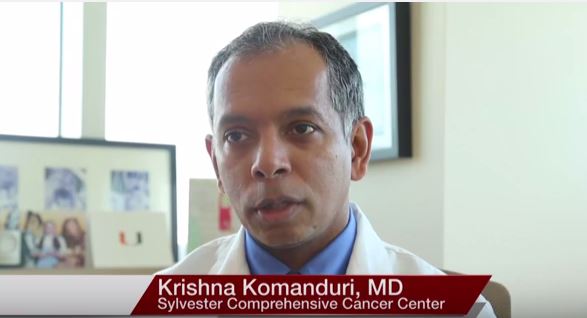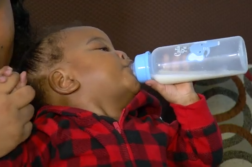Krishna Komanduri, M.D., director of the Adult Stem Cell Transplant Program at Sylvester Comprehensive Cancer Center in Miami, Florida, discusses the effects of stem cell transplants and how they are used to treat cancer.
Interview conducted by Ivanhoe Broadcast News in June 2016.
When it comes to blood cancers it seems that the gold standard in the past has kind of been a bone marrow transplant, is that really changing and are stem cells now a safer treatment?
Dr. Komanduri: There are a number of diseases that are blood cancers for which bone marrow or stem cell transplantation is the standard of care and it’s true that in most cases where we use bone marrow at the original source for the stem cell transplant, we can now collect the cells from the peripheral blood. The reason that we called these procedures bone marrow transplants is that we literally had to do surgeries obtaining the stem cells that re-grow blood cells after chemotherapy from the bone marrow. It turns out that those stem cells which normally reside in the bone marrow can be pushed into the peripheral blood where we can collect them. They’re really not two different types of procedures—in most cases, we can now collect the stem cells that we used to collect from bone marrow from the blood. There are some exceptions where it is preferable to collect bone marrow, but we can now often use stem cells collected from the blood.
What exactly is a stem cell?
Dr. Komanduri: A stem cell is a primitive cell that can give rise to the various types of blood cells that humans need. For example, red blood cells carry oxygen, white blood cells fight infection and platelets clot the blood. Like the seed of a plant can give rise to all of the parts of the plant like the stem, the leaves and the branches, the bone marrow stem cell is a primitive stem cell that can give rise to descendants which become red blood cells, white blood cells and platelets.
How are these stem cells used to treat cancer?
Dr. Komanduri: There are two ways that we use blood stem cells to treat cancers. The first is in what we call autologous transplant where a patient is the donor for his or her own stem cells. In that case we’re giving high doses of chemotherapy that are more likely to cure the patient than the standard doses of chemotherapy that can be given without stem cells. But those very high doses of chemotherapy actually have the secondary effect of wiping out the patient’s healthy blood stem cells. By collecting their stem cells beforehand and then re-infusing them after the high dose chemotherapy we can effectively rescue them from the effects of the high-dose chemotherapy. This type of transplant is most often done for multiple myeloma or lymphoma. The second way that we use stem cells is in what we call the allogeneic or donor transplant setting. Our preferred donor is usually a matched brother or sister but if no sibling is available we go to an unrelated donor from a registry or use other sources of stem cells. This is a common approach for diseases like acute leukemia and other diseases that are either very high risk at diagnosis or once they relapse. In allogeneic transplants, along with stem cells, patients also receive immune system cells like white blood cells from the donor that can actually eliminate the residual cancer.
Why is the use of stem cells in many cases preferable to bone marrow transplant?
Dr. Komanduri: Advantages of stem cells include the fact they can be obtained from the donor without the need to go to the operating room with general anesthesia. A second advantage is that we can usually collect higher numbers of stem cells using peripheral blood, from the peripheral blood, which allows recipients to recovery healthy white blood cells, red blood cells and platelets faster than the recovery that occurs after bone marrow infusion. The duration of hospitalization is typically shorter using peripheral blood stem cell transplants, relative to bone marrow stem cell transplants.
Walk me through the procedure. If a patient is going to have a stem cell transplant, what happens?
Dr. Komanduri: In the autologous transplant setting the patient gets admitted to the hospital following the collection of stem cells as an outpatient. Those stem cells are frozen away in the laboratory. They’re admitted to the hospital and they’re given high doses of chemotherapy over one to six days. Following the completion of the chemotherapy a day or two later the stem cells that were previously collected are infused in to the vein just like a blood transfusion. It’s not a surgery. Then there is typically a ten- to fourteen-day period before the healthy blood cells recover from the stem cells which is just like planting seeds in a garden and getting plants to grow. Once the stem cells are infused, they move into the bone marrow of the recipient and they start re-growing healthy blood counts in the recipient. Once the patient recovers with blood cells that are derived from those stem cells, and the toxicities of the chemotherapy resolve, they can be discharged from the hospital. Typically, this requires a hospitalization that lasts between two and three weeks. In the donor transplant setting we do a similar thing except the stem cells come from another person (a family member or a registry donor). If it’s a family member who’s donating, we typically time the donation of those cells so that the cells are actually collected on the day the patient receives the infusion so those cells do not need to be frozen. Unrelated donor cells come from volunteer donors and collection is coordinated through the National Marrow Donor Program or other national and international registries. That depends on an anonymous donor who is donating precious cells for a recipient he or she does not know, which is a wonderful thing.
Obviously, the survival rates for stem cell transplants are higher, right?
Dr. Komanduri: Correct. We typically do stem cell transplants for diseases where large clinical trials have demonstrated that this is the best way to control or cure the disease. For example, in patients who have relapsed acute leukemia it’s very difficult with chemotherapy alone to ever achieve a cure where at least fifty to seventy percent of patients who undergo a stem cell transplant from a donor can be cured of this fatal disease. Outcomes have dramatically improved and the early risk of serious complications from transplants is a fraction of what it was ten or twenty years ago because of improvements in our ability to collect stem cells but also in supportive care, nursing care and the ability to manage complications that used to occur much more frequently.
Yesterday I interviewed a man who was told he was too old to have a stem cell transplant so obviously you’re able to take patients that others turn away. Why is that?
Dr. Komanduri: I think it’s true of the transplant community in general that we are now able to much more safely perform stem cell transplants. For example, in the early days of transplantation for multiple myeloma, the likelihood of dying early after transplant was as high as ten percent even in individuals under the age of 60. These days routinely we do transplants up to the age of 75 and the likelihood of having serious or fatal complications after transplant is less than one in 100. For most disease, we now routinely transplant patients who are over the age of 65 or 70. We have to make sure that they are in generally good shape and understand that there are risks and complications that are involved. I think I know the patient who you’re talking about and it’s true that he was told that he may be too old for transplant but did very well (and continues to do very well). He’s one of many success stories of patients who were older. This is very important because many physicians in the community still think about the risk of transplantation 10 or 20 years ago and don’t refer to us patients who could be best treated or cured with transplants as they may not understand how much the field has advanced. I think it’s important that patients who have blood cancers consider referral to a transplant center for evaluation even if they have been told that they may not be candidates for that curative therapy.
The patient is George Schwartz. If he had not had treatment, what are the chances that he would be alive today?
Dr. Komanduri: It’s difficult to say in any individual case what the course would be with or without treatment. But we know that large randomized control trials that were performed 20 years ago proved that patients who had treatment for multiple myeloma (his disease) and did not go on to get stem cell transplants had significantly shorter survivals than patients who had initial chemotherapy and then went on to have an autologous transplant. In multiple myeloma, while we don’t consider transplants or any other option to be curative, we know that the likelihood of surviving longer without symptoms is improved dramatically by transplant in many patients. Mr. Schwartz is lucky to be living a very normal life. The chance of that outcome is much greater for patients who had a stem cell transplant. Four recent studies that have been repeated in the modern era of myeloma therapy confirm that stem cell transplants have a very important role for most patients with multiple myeloma, and in my view should be considered the standard of care following initial chemotherapy.
Is there anything else you would like to say that I haven’t asked you?
Dr. Komanduri: I’m very privileged to be a stem cell transplant physician at this point in time. The field is rapidly evolving and we at Sylvester have rapidly grown our program and are providing very exciting options both with autologous and allogeneic transplants. Finally, we are also using immunotherapies that harness the immune system without transplantation with amazing results. Overall, it is a very exciting time for doctors and patients alike in this field.
END OF INTERVIEW
This information is intended for additional research purposes only. It is not to be used as a prescription or advice from Ivanhoe Broadcast News, Inc. or any medical professional interviewed. Ivanhoe Broadcast News, Inc. assumes no responsibility for the depth or accuracy of physician statements. Procedures or medicines apply to different people and medical factors; always consult your physician on medical matters.
If you would like more information, please contact:
Patrick Bartosch
Patrick.bartosch@med.miami.edu
Sign up for a free weekly e-mail on Medical Breakthroughs called
First to Know by clicking here.




